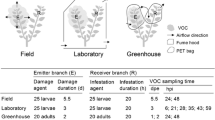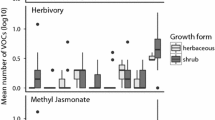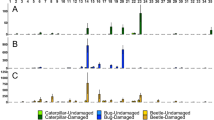Abstract
One of the first observations that plants might utilize cues released by damaged neighbors under natural conditions was made in birch forests in 1985. However, the mechanisms underlying the observations were not determined, and birch (Betula spp.) has been neglected as a study system for inter-plant interaction ever since. Volatiles released by vegetative plant parts in response to herbivore damage play important roles as signals in plant-to-plant interactions in a range of woody and herbaceous plant species, and also have been shown to mediate signaling between branches of the same plant that have limited vascular connection. We established greenhouse experiments to assess: 1) whether exposure to plant volatiles from herbivore-damaged birches primes defense responses in undamaged neighbors; and 2) whether defenses also are primed in undamaged parts of the same plants with limited vascular connection. We observed a priming of defense responses, which were manifested in an augmented emission of terpenes and aromatic compounds in undamaged conspecific neighbors, and also an augmented emission of green leaf volatiles in systemic branches. Our work provides strong evidence of inter-plant signaling by volatiles, and an intra-plant systemic response in birch. However, the responses are specific, with emissions of different groups of plant volatiles typifying the primed response. This work complements and extends the previous work conducted with a natural population of birches.



Similar content being viewed by others
References
Agelopoulos N, Dicke M, Posthumus M (1995) Role of volatile infochemicals emitted by feces of larvae in host-searching behavior of parasitoid Cotesia rubecula (hymenoptera: Braconidae): a behavioral and chemical study. J Chem Ecol 21:1789–1811. doi:10.1007/BF02033677
Appel HM, Cocroft RB (2014) Plants respond to leaf vibrations caused by insect herbivore chewing. Oecologia 175:1257–1266. doi:10.1007/s00442-014-2995-6
Arimura G, Tashiro K, Kuhara S, Nishioka T, Ozawa R, Takabayashi J (2000) Gene responses in bean leaves induced by herbivory and by herbivore-induced volatiles. Biochem Biophys Res Commun 277:305–310. doi:10.1006/bbrc.2000.3672
Arimura G, Ozawa R, Horiuchi J, Nishioka T, Takabayashi J (2001) Plant-plant interactions mediated by volatiles emitted from plants infested by spider-mites. Biochem Syst Ecol 29:1049–1061
Babikova Z, Gilbert L, Bruce TJA, Birkett M, Caulfield JC, Woodcock C, Pickett JA, Johnson D (2013) Underground signals carried through common mycelial networks warn neighbouring plants of aphid attack. Ecol Lett 16:835–843. doi:10.1111/ele.12115
Baldwin I, Schultz J (1983) Rapid changes in tree leaf chemistry induced by damage – evidence for communication between plants. Science 221:277–279. doi:10.1126/science.221.4607.277
Dannon EA, Tamo M, Van Huis A, Dicke M (2010) Effects of volatiles from Maruca vitrata larvae and caterpillar-infested flowers of their host plant Vigna unguiculata on the foraging behavior of the parasitoid Apanteles taragamae. J Chem Ecol 36:1083–1091. doi:10.1007/s10886-010-9859-2
De Moraes C, Lewis W, Pare P, Alborn H, Tumlinson J (1998) Herbivore-infested plants selectively attract parasitoids. Nature 393:570–573. doi:10.1038/35069058
Dudareva N, Negre F, Nagegowda DA, Orlova I (2006) Plant volatiles: Recent advances and future perspectives. Crit Rev Plant Sci 25:417–440. doi:10.1080/07352680600899973
Dudareva N, Klempien A, Muhlemann JK, Kaplan I (2013) Biosynthesis, function and metabolic engineering of plant volatile organic compounds. New Phytol 198:16–32. doi:10.1111/nph.12145
Engelberth J, Alborn H, Schmelz E, Tumlinson J (2004) Airborne signals prime plants against insect herbivore attack. Proc Natl Acad Sci U S A 101:1781–1785. doi:10.1073/pnas.0308037100
Engelberth J, Seidl-Adams I, Schultz JC, Tumlinson JH (2007) Insect elicitors and exposure to green leafy volatiles differentially upregulate major octadecanoids and transcripts of 12-oxo phytodienoic acid reductases in Zea mays.. Mol Plant-Microbe Interact 20:707–716. doi:10.1094/MPMI-20-6-0707
Engelberth J, Contreras CF, Dalvi C, Li T, Engelberth M (2013) Early transcriptome analyses of Z-3-hexenol-treated zea mays revealed distinct transcriptional networks and anti-herbivore defense potential of green leaf volatiles. Plos One 8. doi: 10.1371/journal.pone.0077465
Farag MA, Paré PW (2002) C-6-green leaf volatiles trigger local and systemic VOC emissions in tomato. Phytochemistry 61:545–554
Fowler S, Lawton J (1985) Rapidly induced defenses and talking trees – the devil’s advocate position. Am Nat 126:181–195. doi:10.1086/284408
Frost CJ, Appel M, Carlson JE, De Moraes CM, Mescher MC, Schultz JC (2007) Within-plant signalling via volatiles overcomes vascular constraints on systemic signalling and primes responses against herbivores. Ecol Lett 10:490–498. doi:10.1111/j.1461-0248.2007.01043.x
Frost CJ, Mescher MC, Dervinis C, Davis JM, Carlson JE, De Moraes CM (2008) Priming defense genes and metabolites in hybrid poplar by the green leaf volatile cis-3-hexenyl acetate. New Phytol 180:722–733. doi:10.1111/j.1469-8137.2008.02599.x
Girón-Calva PS, Molina-Torres J, Heil M (2012) Volatile dose and exposure time impact perception in neighboring plants. J Chem Ecol 38:226–228
Hartikainen K, Riikonen J, Nerg A, Kivimaenpaa M, Ahonen V, Tervahauta A, Karenlampi S, Maenpaa M, Rousi M, Kontunen-Soppela S, Oksanen E, Holopainen T (2012) Impact of elevated temperature and ozone on the emission of volatile organic compounds and gas exchange of silver birch (Betula pendula Roth). Environ Exp Bot 84:33–43. doi:10.1016/j.envexpbot.2012.04.014
Haukioja E, Suomela J, Neuvonen S (1985) Long-term inducible resistance in birch foliage - triggering cues and efficacy on a defoliator. Oecologia 65:363–369. doi:10.1007/BF00378910
Heil M, Adame-Álvarez RM (2010) Short signalling distances make plant communication a soliloquy. Biol Lett 6:843–845. doi:10.1098/rsbl.2010.0440
Heil M, Karban R (2010) Explaining evolution of plant communication by airborne signals. Trends Ecol Evol 25:137–144. doi:10.1016/j.tree.2009.09.010
Heil M, Kost C (2006) Priming of indirect defences. Ecol Lett 9:813–817
Heil M, Silva Bueno JC (2007) Within-plant signaling by volatiles leads to induction and priming of an indirect plant defense in nature. Proc Natl Acad Sci U S A 104:5467–5472. doi:10.1073/pnas.0610266104
Heil M, Ton J (2008) Long-distance signalling in plant defence. Trends Plant Sci 13:264–272. doi:10.1016/j.tplants.2008.03.00
Holopainen J (2004) Multiple functions of inducible plant volatiles. Trends Plant Sci 9:529–533. doi:10.1016/j.tplants.2004.09.006
Ibrahim MA, Mäenpää M, Hassinen V, Kontunen-Soppela S, Malec L, Rousi M, Pietikäinen L, Tervahauta A, Kärenlampi S, Holopainen JK, Oksanen EJ (2010) Elevation of night-time temperature increases terpenoid emissions from Betula pendula and Populus tremula. J Exp Bot 61:1583–1595. doi:10.1093/jxb/erq034
Ishizaki S, Shiojiri K, Karban R, Ohara M (2011) Effect of genetic relatedness on volatile communication of sagebrush (Artemisia tridentata). J Plant Interact 6:193–193. doi:10.1080/17429145.2010.544770
Kaitaniemi P, Ruohomäki K (1999) Effects of autumn temperature and oviposition date on timing of larval development and risk of parasitism in a spring folivore. Oikos 84:435–442
Karban R, Shiojiri K (2009) Self-recognition affects plant communication and defense. (vol 12, pg 502, 2009). Ecol Lett 12:999–999. doi:10.1111/j.1461-0248.2009.01348.x
Karban R, Maron J, Felton G, Ervin G, Eichenseer H (2003) Herbivore damage to sagebrush induces resistance in wild tobacco: evidence for eavesdropping between plants. Oikos 100:325–332. doi:10.1034/j.1600-0706.2003.12075.x
Karban R, Shiojiri K, Huntzinger M, McCall A (2006) Damage-induced resistance in sagebrush: volatiles are key to intra- and interplant communication. Ecology 87:922–930. doi:10.1890/0012-9658(2006)87[922:DRISVA]2.0.CO;2
Kessler A, Halitschke R, Diezel C, Baldwin I (2006) Priming of plant defense responses in nature by airborne signaling between Artemisia tridentata and Nicotiana attenuata. Oecologia 148:280–292. doi:10.1007/s00442-006-0365-8
Klemola T, Ammunet T, Andersson T, Klemola N, Ruohomaki K (2012) Larval parasitism rate increases in herbivore-damaged trees: a field experiment with cyclic birch feeding moths. Oikos 121:1525–1531. doi:10.1111/j.1600-0706.2011.20096.x
Kost C, Heil M (2006) Herbivore-induced plant volatiles induce an indirect defence in neighbouring plants. J Ecol 94:619–628. doi:10.1111/j.1365-2745.2006.01120.x
Kuntasal ÖO, Karman D, Wang D, Tuncel SG, Tuncel G (2005) Determination of volatile organic compounds in different microenvironments by multibed adsorption and short-path thermal desorption followed by gas chromatographic–mass spectrometric analysis. J Chromatogr A 1099:43–54. doi:10.1016/j.chroma.2005.08.093
Li T, Holopainen JK, Kokko H, Tervahauta AI, Blande JD (2012) Herbivore-induced aspen volatiles temporally regulate two different indirect defences in neighbouring plants. Funct Ecol 26:1176–1185. doi:10.1111/j.1365-2435.2012.01984.x
Loreto F, Schnitzler J (2010) Abiotic stresses and induced BVOCs. Trends Plant Sci 15:154–166. doi:10.1016/j.tplants.2009.12.006
Mäntylä E, Alessio GA, Blande JD, Heijari J, Holopainen JK, Laaksonen T, Piirtola P, Klemola T (2008) From plants to birds: higher avian predation rates in trees responding to insect herbivory. PLoS ONE 3:e2832. doi:10.1371/journal.pone.0002832
Mirabella R, Rauwerda H, Struys EA, Jakobs C, Triantaphylidès C, Haring MA, Schuurink RC (2008) The Arabidopsis her1 mutant implicates GABA in (E)-2-hexenal responsiveness. Plant J 53:197–213
Mutikainen P, Walls M, Ovaska J (1996) Herbivore-induced resistance in Betula pendula: the vole of plant vascular architecture. Oecologia 108:723–727. doi:10.1007/BF00329048
Orians CM, Ardόn M, Mohammad BA (2002) Vascular architecture and patchy nutrient availability generate within-plant heterogeneity in plant traits important to herbivores. Am J Bot 89:270–278
Orians CM, van Vuuren MM, Harris NL, Babst BA, Ellmore GS (2004) Differential sectoriality in long dis-tance transport in temperate tree species, evidence from dye flow, 15N transport, and vessel element pitting. Trees 18:501–509
Pearse IS, Hughes K, Shiojiri K, Ishizaki S, Karban R (2013) Interplant volatile signaling in willows: revisiting the original talking trees. Oecologia 172:869–875. doi:10.1007/s00442-013-2610-2
Peng J, van Loon JJA, Zheng S, Dicke M (2011) Herbivore-induced volatiles of cabbage (Brassica oleracea) prime defence responses in neighbouring intact plants RID B-2300-2010. Plant Biol 13:276–284. doi:10.1111/j.1438-8677.2010.00364.x
Rhoades D (1983) Responses of alder and willow to attack by tent caterpillars and webworms – evidence for pheromonal sensitivity of willows. ACS Symp Ser 208:55–68
Rodriguez-Saona CR, Rodriguez-Saona LE, Frost CJ (2009) Herbivore induced volatiles in the perennial shrub, Vaccinium corymbosum, and their role in inter-branch signaling. J Chem Ecol 35:163–175. doi:10.1007/s10886-008-9579-z
Ruohomäki K, Tanhuanpaa M, Ayres M, Kaitaniemi P, Tammaru T, Haukioja E (2000) Causes of cyclicity of Epirrita autumnata (lepidoptera, geometridae): Grandiose theory and tedious practice. Pop Ecol 42:211–223. doi:10.1007/PL00012000
Ruther J, Kleier S (2005) Plant-plant signaling: Ethylene synergizes volatile emission in Zea mays induced by exposure to (Z)-3-hexen-1-ol. J Chem Ecol 31:2217–2222
Ruuhola T, Yang S, Ossipov V, Haukioja E (2008) Foliar oxidases as mediators of the rapidly induced resistance of mountain birch against Epirrita autumnata. Oecologia 154:725–730. doi:10.1007/s00442-007-0869-x
Sprugel DG, Hinckley TM, Schaap W (1991) The theory and practice of branch autonomy. Annu Rev Ecol Syst 22:309–334
Ton J, D’Alessandro M, Jourdie V, Jakab G, Karlen D, Held M, Mauch-Mani B, Turlings TCJ (2007) Priming by airborne signals boosts direct and indirect resistance in maize. Plant J 49:16–26. doi:10.1111/j.1365-313X.2006.02935.x
Vuorinen T, Nerg A, Vapaavuori E, Holopainen J (2005) Emission of volatile organic compounds from two silver birch (Betula pendula Roth) clones grown under ambient and elevated CO2 and different O3 concentrations. Atmos Environ 39:1185–1197. doi:10.1016/j.atmosenv.2004.09.077
Vuorinen T, Nerg A-M, Syrjälä L, Peltonen P, Holopainen JK (2007) Epirrita autumnata induced VOC emission of silver birch differ from emission induced by leaf fungal pathogen. Arthropod Plant Interact 1:159–165. doi:10.1007/s11829-007-9013-4
Vuorisalo T, Hutchings MJ (1996) On plant sectoriality, or how to combine the benefits of autonomy and integration. Vegetatio 127:3–8
Yan ZG, Wang CZ (2006) Wound-induced green leaf volatiles cause the release of acetylated derivatives and a terpenoid in maize. Phytochemistry 67:34–42
Zanne AE, Sweeney K, Sharma M, Orians CM (2006) Patterns and consequences of differential vascular sectoriality in 18 temperate tree and shrub species. Func Ecol 20:200–206
Zebelo SA, Matsui K, Ozawa R, Maffei ME (2012) Plasma membrane potential depolarization and cytosolic calcium flux are early events involved in tomato (Solanum lycopersicon) plant-to-plant communication. Plant Sci 196:93–100. doi:10.1016/j.plantsci.2012.08.006
Acknowledgments
We thank Marjo Anttila for assistance in establishing the experiment as well as two anonymous referees for valuable comments on an earlier version of this manuscript. Financial support was provided by the Academy of Finland (project nos. 256050 251898 and 141053). We also acknowledge the European Science Foundation EUROCORES Programme EuroVOL, which was supported by funds from the Academy of Finland.
Author information
Authors and Affiliations
Corresponding author
Electronic supplementary material
Below is the link to the electronic supplementary material.
ESM 1
(PDF 120 kb)
Rights and permissions
About this article
Cite this article
Girón-Calva, P.S., Li, T., Koski, TM. et al. A Role for Volatiles in Intra- and Inter-Plant Interactions in Birch. J Chem Ecol 40, 1203–1211 (2014). https://doi.org/10.1007/s10886-014-0514-1
Received:
Revised:
Accepted:
Published:
Issue Date:
DOI: https://doi.org/10.1007/s10886-014-0514-1




